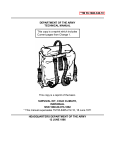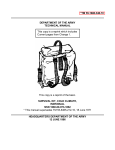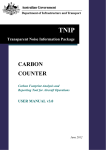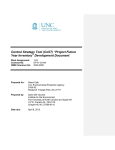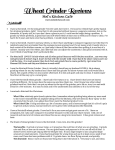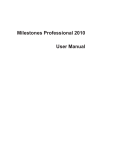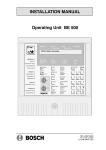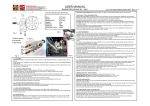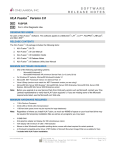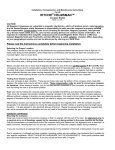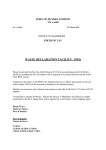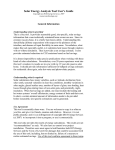Download Overview
Transcript
2 Overview In recent years new transparency concepts for describing and assessing aircraft noise have emerged in response to perceived shortcomings in conventional approaches. To date these new concepts have largely been used for historic reporting of noise. There are now increasing calls for these approaches to be extended to show projections of aircraft noise exposure patterns for future time periods. In particular there is interest in using the new descriptors in formal reports such as Environmental Impact Statements and airport Master Plans. TNIP Future Year Builder is a software product, written in Microsoft Access, which facilitates the building of operating scenarios, and the production of associated aircraft noise information, for future time periods. It is an ancillary product to the Department of Transport and Regional Services’ noise descriptor software package TNIP (Transparent Noise Information Package) The key purpose of TNIP Future Year Builder is to enable the generation, within TNIP, of information about future aircraft noise exposure patterns which goes beyond conventional ‘annual average day’ information. Nevertheless, the program can be used to construct an ‘average day’ which can be used within the US Federal Aviation Administration’s Integrated Noise Model (INM). A key feature of TNIP Future Year Builder is that the future year scenarios (for use both within TNIP and INM) are constructed without recourse to the statistical analysis of historic wind data. Experience has shown that to accurately allocate future aircraft movements to runways based on the statistical analysis of historic wind data is a very difficult task. Feedback Sought This version of TNIP Future Year Builder is essentially a pre-beta concept version of the software. It is functional and can be used to produce a future year for use within TNIP or to generate an INM average day but it is not fully error trapped and the user interface has not been optimised. At this stage we are seeking feedback on the basic concept of - generating aircraft noise information for the future which is not simply restricted to the ‘annual average day’ - developing future aircraft noise information, including an INM ‘average day’, without recourse to the statistical analysis of historic wind data. You may wish to email any comments on these concepts to Dave Southgate at [email protected] Comments or queries on the software may be emailed to Jonathan Firth at [email protected] 3 Table of Contents Page No Overview Part 1 – The Concept 1 Introduction 6 1.1 1.2 6 7 Background The TNIP FYB output 2 Scenarios Rather than Forecasts 8 3 Building the Future Year 9 3.1 3.2 9 10 4 Basic concept Key process steps Avoiding Statistical Analysis of Historic Wind Data 12 4.1 4.2 12 12 Allocating runway movements using encapsulated wind data Allocating runway movements through crossmatching Part 2 – Example Applications 1 Introduction 15 2 Airport Master Planning 15 2.1 2.2 15 15 3 4 Incremental growth scenario Proposed new infrastructure Environmental Assessment – Major New Project 16 3.1 3.2 3.3 16 16 17 New airport From one runway to parallel runways New airspace structure Consultative Committees 18 4.1 4.2 18 18 Change in noise preferred runways Introduction of new service Part 3 – Generating the Future Year Data Set 1 Introduction 20 2 Loading a Movements Data File 21 3 Converting Passenger Numbers into Aircraft Movements 23 4 4 Creating a Changes Table 26 4.1 4.2 4.3 4.4 4.5 4.6 26 27 28 29 30 30 Introduction Adding a New Movement record Adding a Change Aircraft record Adding a Change Runway record Adding a Delete Movements record Dates in the Changes Table 5 Applying the Changes 32 6 Checking Constraints 33 6.1 6.2 6.3 6.4 34 34 35 7 Airport cap (maximum movement rate) Maximum single runway movement rate Parallel runway operations Non-permitted runway/port/aircraft type/operation type combinations The Output File 36 37 Part 4 – Generating the INM Average Day 1 Generating the INM Average Day 39 Part 5 – Extras 1 2 Reports 41 1.1 1.2 1.3 Operations by port Total seats by port Total seats/PAX 41 42 42 Maintaining the Look-up Tables 43 2.1 2.2 43 44 The aircraft table The stage length table Part 6 – Appendix 1 TNIP FYB Files 46 1.1 1.2 1.3 1.4 46 46 47 47 The key input file – the seed year data set The output file – the future year data set The INM average day output file Changes Files 5 Part 1 6 1 Introduction 1.1 Background Future aircraft noise is conventionally portrayed using logarithmic noise contours based on an annual average day - a number of such noise metrics are in common use throughout the world. In Australia these logarithmic contours are based on the ANEF (Australian Noise Exposure Forecast) system. ANEF contours were developed in the early 1980s as a land use planning tool. However, over time they became to be used as a general tool for describing and assessing future aircraft noise. For example, they were used in Environmental Impact Statements to portray what aircraft noise exposure patterns would be like if a proposed project were approved. In recent years a number of formal Public Inquiries and reports have heavily criticised the way logarithmic contours have been used to portray and/or assess future aircraft noise – in Australia most notably the report of the 1995 Senate Select Committee on Aircraft Noise in Sydney (Falling on Deaf Ears). As a result of these criticisms a range of new noise descriptor concepts have evolved in Australia. In essence these new approaches are based on describing aircraft noise using ‘everyday talk’ and are designed to give a picture of aircraft noise exposure patterns that a non-expert can understand and relate to. The Department has published two papers which set out these alternative approaches to describing and assessing aircraft noise: Expanding Ways to Describe and Assess Aircraft Noise (2000) and Guidance Material for Selecting and Providing Aircraft Noise Information (2003) (joint publication with Environment Australia). In parallel with this work the Department has developed a software package TNIP (Transparent Noise Information Package) which is designed to facilitate rapid production of these new descriptors. TNIP also can be used as a transparency tool which allows non-experts to gain an insight into the construction and workings of conventional logarithmic noise contours such as the ANEF. Public criticism of the way future noise is conventionally described has often focussed on the ‘annual average day’ – it is claimed that this type of information is misleading and that it hides the variations and extremes in aircraft noise exposure patterns. In response, a key aim of the new descriptors is to provide information that goes beyond the average day – to clearly describe, for example, what noise will be like on the ‘worst days’, the frequency of ‘good’/’bad’ days, what noise will be like at sensitive times, etc. The examples in Figures 1.1 & 1.2 provide two ways of describing noise in the evening period at Sydney Airport. This information has been generated using TNIP. The images shown in Figures 1.1 & 1.2 are for a past period. TNIP Future Year Builder (TNIP FYB) has been developed to generate this type of information for future periods. Another key weakness of projections of future noise has been the reliance on statistical analysis of historic wind data to predict which runways/flight paths aircraft will use. There are a number of examples of major projects in Australia where statistically based runway use predictions have proven to be very inaccurate when the project has commenced. An important feature of TNIP FYB is that it generates the future year without the need to analyse historic wind data. 7 1.2 The TNIP FYB output In essence TNIP FYB generates an output file which contains a line of information (seven variables) for each flight at an airport over the period covered by the output data set (usually a future year). Therefore, for example, the output file may be a file with 350, 000 lines which covers a year’s operations at an airport (the file will be approximately 10 MB in size). This file has the same format as a TNIP movements data file. This file can be used in two key ways. To produce noise information using TNIP TNIP movements data files are used within TNIP to produce Flight Path Movements and Respite charts and partial N70 contours (see the TNIP User’s Manual for details). TNIP FYB facilitates the generation of these files for any user defined future time periods (eg future years). Once the data set for a future period is generated it can be used within TNIP to produce, for example, information on noise exposure patterns for the busiest hours, days, weeks, etc and for sensitive times such as evenings and weekends within that future period. Similarly information on noise exposure patterns can be made for various periods within a year (eg winter/summer) and, if separate data sets are generated for a number of individual seed years, the range of likely noise outcomes between years can be shown. To generate an INM ‘Average Day’ TNIP FYB has the facility to convert the output file into an ‘average day’ that can be used as input into a study within the United States Federal Aviation Administration’s Integrated Noise Model (INM). The ‘average day’ is a file which shows the allocation of movements to the runways at an airport by separate aircraft types for each of the three INM specified time periods (‘day’, ‘evening’ and ‘night’). TNIP FYB lets the user define the three time periods of the day and also select whether the average day is to be for a whole year or for part of that year. While the average day produced by TNIP FYB v0.1 simply shows the allocation of aircraft to runways it is envisaged that in later versions this can be taken further. The TNIP FYB output file specifies the origin/destination for each movement and therefore the data set contains information which should enable not only the allocation of movements to the runways but also the allocation of movements to particular flight paths (assuming these allocations are based on aircraft movements from/to origins/destinations being based on STARS and SIDS). 8 2 Scenarios Rather than Forecasts Experience has shown that it is extremely difficult to accurately forecast aircraft movement numbers at an airport when the future time horizon is more than a few years. This problem is magnified when attempts are made to predict the numbers and types of aircraft that will use particular runways. Big discrepancies in the past between forecasts of aircraft movement numbers and actual outcomes have led to public questioning of the credibility of Environmental Impact Statements (EISs). Given that it has proven very difficult to forecast aircraft movement numbers with any great accuracy for a future average day, it may be argued that very little trust can be placed in noise data for a future year which relates to specific periods of the day (eg data relating to the evening period). This is considered to be a very valid point and the fundamental thinking underlying TNIP FYB is therefore one of producing scenarios rather than forecasts. The essential aim is to produce robust aircraft noise data on a range of operationally feasible alternatives rather than to be definitive about what will happen. The most likely of the scenarios can be selected as the forecast in circumstances where a prediction of the future is required. When developing future airport operating scenarios the question of interest generally takes one of two forms. Either ‘What is the likely range of noise exposure patterns when the airport handles 40 million passengers a year?’, or ‘What will it be like in the year 2015?’. TNIP FYB has therefore been designed to generate scenarios based either on passenger throughput or for a specific time horizon. Clearly there may be a number of operating scenarios at an airport for it to achieve a given throughput in terms of numbers of passengers – principally involving the balance between aircraft size and the number of aircraft movements. TNIP FYB therefore is designed to facilitate the rapid generation of aircraft noise information for a number of scenarios. This enables decision-makers and the community to be aware of the likely range of noise outcomes from a project. It also enables the sensitivity of the noise outcomes to inaccuracies in ‘forecasts’ to be appreciated. 9 3 Building the Future Year 3.1 Basic concept TNIP FYB produces future years by building on past operational experience. The program operates by injecting projected movements into an actual movements data set for a past time period. The future year data base which results from this injection process can be used within TNIP to generate Flight Path Movements and Respite Charts and partial N70 contours. It can also be used to generate an INM average day which can then be used as input into an INM study. TNIP FYB operates on TNIP movements data files which consist of one line of data for each operation at an airport – this line of data contains seven variables. An extract of a movements data file for Sydney Airport is shown below (see the TNIP User’s Manual for more details). TNIP FYB injects movements into the data set for a past year by allowing the user to select growth rates on any or all routes into and out of the airport in any specified hour. The program then allows the user to select how this new demand will be met – either by increasing the number of existing aircraft types or by changing the aircraft types. The program allows the user to look at the number of seats on different aircraft types and to vary assumed load factors to gauge what aircraft type and/or frequency of operation will meet the anticipated new passenger demand. The new flights can be injected on a micro basis (eg specified hours, days) or on macro selections (eg weekends/weekdays) and over a user selected time period (say five years). The steps described above produce the data for the times and aircraft type of the individual movements at an airport. The other key task for TNIP FYB is to allocate the movements to the correct runways. When injecting movements the program looks for any operations in the existing data file which are identical to the one (or ones) being injected (eg arrival from BNE) within a 30 minute window each side of the injection time (ie a one hour time period). If such operations are found the injected movements are allocated to the same runway as that used by the aircraft already in the data set. If no such movements are found the aircraft is allocated to the most commonly used runway in the window time period for that type of operation (ie landing or departure). It is implicit in the above description that the operating regime at the airport in the future year will be the same as that in the seed year (eg there will be no new runways). This will of course not always be the case. The way TNIP FYB caters for these circumstances is discussed in the next section and in Part 2. 10 Assessments can be made of possible annual variations in noise exposure patterns by seeding more than one base year with the predicted number of movements needed to achieve the scenario airport passenger throughput. Each individual data set will, by default, take into account the weather patterns for each of the selected seed years. If the aim is to generate information on noise exposure patterns for an ‘average’ year, this can be obtained by generating separate movements data sets for a number of seed years and then averaging the data over the period covered by the separate data sets. Alternatively a consolidated file constructed from each of the separate data sets can be used within TNIP to generate the aimed for information. 3.2 Key process steps Generation of the future year involves the carrying out of a number of discrete steps. TNIP FYB has a modular structure that allows the user to sequentially follow these steps in a logical and progressive manner. The key steps in building the data set for a future year are 1. Select and load into the program the data set which is to be seeded to form the data set for the future year. 2. Determine the changes in the aircraft movements, aircraft types, etc that will need to be made to achieve the scenario airport throughput in terms of numbers of passengers. 3. Develop a ‘changes’ file which contains the changes in aircraft movements developed in Step 2 and allocates these by time of day, day of week, runway, etc. 4. Apply the changes file to the selected seed data set (the program automatically injects the changes according to the rules described above). 5. Check that the new data set for the future year is valid - this validation process involves checking that the future year data set does not contain movements which conflict with the airport’s operating constraints (eg maximum number of movements per hour on a runway, departures to certain destinations only possible off certain runways, etc) - these constraints can be tailored to meet specifications selected by the user - re-allocate movements which have been identified as not complying with the constraints to other runways, times or aircraft by returning to Step 3 - repeat the re-allocation/checking process until all operations have been correctly allocated. 6. Use the final data set - within TNIP to produce Flight Path Movements and Respite charts and partial N70 contours - within TNIP FYB to generate an INM average day and then use this as input into an INM study. These steps are shown in the flowchart at Figure 1.3. Figure 1.3: TNIP Future Year Builder Flowchart Load data file for seed year Aircraft type + Stage length Look-up Tables Check data STEP 1 ---------------------------------------------------------------------------------------------------------------------------- Passenger growth rates Aircraft types Aircraft movements Load factors STEP 2 ---------------------------------------------------------------------------------------------------------------------------Aircraft type Generate changes file Aircraft numbers Runways Times, days of week, etc STEP 3 ---------------------------------------------------------------------------------------------------------------------------Apply changes to seed year file STEP 4 ---------------------------------------------------------------------------------------------------------------------------Check constraints • • • • Runway capacity Runway/aircraft type combination Runway/port combination Airport capacity STEP 5 ---------------------------------------------------------------------------------------------------------------------------Movements data set for future year Use in TNIP to generate flight path movements & respite charts + partial N70 contours for future year Generate INM average day Use in INM study STEP 6 ---------------------------------------------------------------------------------------------------------------------------- 11 In addition to generating the new TNIP movements data file, the program also allows the user to generate a number of statistical reports from the data set that is resident in the program. 12 4 Avoiding Statistical Analysis of Historic Wind Data Conventionally, when developing noise contours for a future ‘annual average day’ for a new airport, or for an airport where there is to be some major change to operational procedures (eg a new runway), some form of statistical analysis of historic wind data is carried out to determine the allocation of aircraft movements to runways. These analyses determine what proportion of the average day certain runways will, and will not, be available due to wind constraints and this information is then used to allocate the movements between runways according to predetermined priorities for particular runway modes. Unfortunately this approach has not always produced robust results. For example, in the EIS for the Third Runway at Sydney Airport this approach led to a prediction that approximately 13% of the departures at the airport would be to the north when the new parallel runway was introduced. In practice this figure was approximately 30% for the year 1995 (the only calendar year when the Airport operated in full parallel runway mode). This discrepancy caused the credibility of the EIS to be severely questioned. The Senate Select Committee on Aircraft Noise in Sydney was particularly critical of this aspect of the EIS and found that ‘There are reasonable grounds to suspect that the failure of the EIS to assess objections to its [long term wind analysis] methodology at the time was either negligent or deliberate’. TNIP FYB has been deliberately designed to allocate movements to runways within future years (including a future annual average day) without the need for the statistical analysis of historic wind data. This is achieved either by using data sets which naturally encapsulate historic wind data, or by allocating the movements through crossmatching individual movements with historic wind data. 4.1 Allocating runway movements using encapsulated wind data As indicated in the previous section, TNIP FYB builds the future year by injecting movements into the data set for a past year at times (hours, days of week, etc) specified by the user. The program then automatically allocates the movements to the runways that were in use at the injection times in the seed year. If there are no changes in the operating regime between the seed year and the future year this approach automatically takes into account the operational constraints acting at the time of the injected movement. Factors such as wind/weather (and other constraints) will have determined which runways were in use at the injection time in the seed year (and therefore which runways would be in use in the future year if the wind regime were replicated). This approach is also valid in circumstances where there are changes in runways and the seed year data set inherently contains the wind data. For example, if an airport is going from a single runway to a parallel runway configuration, allocating movements to the new the runway will be relatively straightforward since the wind regime will be de facto contained in the seed year data set. This example is briefly explored in Part2, Section 3.1. 4.2 Allocating runway movements through crossmatching It will not always be possible to use past experience as the basis for allocating runway movements for the future year. For example, when aircraft are being allocated to runways for a new airport there will be no past runway usage data. At an existing airport, when aircraft movements are being transferred between runways of different orientation, or changes in the direction of preferred use of particular runways are being examined, past operating experience may be of little relevance. In these circumstances, the future year data set can be built up by allocating movements to the runways through crossmatching movements and wind data sets on a movement by 13 movement basis according to pre-determined allocation rules. As with all automatically constructed future years constraints checking is important. In particular, the crossmatching approach will need to include rules about the minimum times between runway mode changes. Varying the criteria for runway allocation (eg the hierarchy for noise preferred runways) permits a number of future flow direction scenarios to be developed which can be used to indicate the possible range in noise exposure outcomes. This is discussed in more detail in the example on new airspace structure contained in sub-section 3.2 in Part 2. In a similar manner to building the future year through using data sets which have encapsulated wind data, if an ‘average’ year is being aimed for (either for use in TNIP or INM) this can be obtained by crossmatching the movements data set for the future year with the wind data for a number of past years (ie building a number of separate years). This then enables the average day to be constructed by averaging the data over the number of years that have been subject to the wind/movement crossmatching (or by generating a consolidated data set for the period covered by the individual data sets). This version of TNIP FYB does not contain the facility to carry out allocation of runway movements through crossmatching and this will need to be performed outside the program (eg through setting up and comparing Microsoft Access wind and movements data sets). It is envisaged that this facility will be incorporated into later versions of TNIP FYB. With TNIP FYB v0.1, when examining circumstances requiring runway allocation through crossmatching, the program can be used to generate the data set which contains the movement times and aircraft types for the future year. This data set must then be exported outside the program to carry out the runway allocation of the future year movements. Once the runway movements have been allocated outside TNIP FYB using crossmatching the future year file can be imported back into TNIP FYB for constraints checking, generating an INM average day and for producing reports. 14 Part 2 15 1 Introduction This Part of the document contains examples of applications for which TNIP Future Year Builder can be used. Examples are given for three broad areas where the program may be used to advantage: · · · 2 airport Master Planning environmental assessment of a major project discussions with communities on possible changes to airport operations (eg within Noise Abatement Committees). Airport Master Planning Under the Airports Act 1996 leased Federal airports are required to submit a Master Plan and to update this on a five-year cycle. A requirement of the Master Plan is the production of an ANEF contour map with a 20 year horizon. At a number of airports there have been community calls for additional, flight path based, aircraft noise information to be included in the Master Plan to supplement the ANEF contours. This type of information, such as the Flight Path Movements and Respite charts, can be produced by TNIP using movements data sets generated using TNIP FYB. 2.1 Incremental growth scenario This example applies to those airports where it is projected that the airport will be able to cater for the incremental growth in traffic/passengers during the 20 year planning period without the need to construct new runway infrastructure. At these airports it is relatively straightforward to use TNIP FYB to build data sets for the Master Plan’s 20 year horizon since the wind data will be encapsulated in existing movements data sets. The program allows annual growth figures for each route into and out of the airport in any selected time period and for any selected days to be injected into the seed year data set to produce the movements data file for the target year. As indicated earlier, it is problematic to generate a robust scenario for a specified future year and therefore it is strongly recommended that a number of scenarios, for a range of feasible operating scenarios, be produced. Once the scenario data sets have been generated they can then be imported into TNIP and used to generate Flight Path Movement and Respite Charts for the future year (or parts of the year, etc). The future year data sets can also be used to generate average day runway allocation files for the production of noise contours using INM. While not generated with TNIP FYB, an example of where future Flight Path Movements and Respite charts have been published in an airport Master Plan is in the Sydney Airport draft Master Plan released in August 2003 (see Figs 2.1 & 2.2). 2.2 Proposed new infrastructure In some Master Plans an airport will indicate that it proposes to construct major new infrastructure during the 20 year planning horizon (eg the proposed new parallel runway at Brisbane Airport). In these circumstances the noise exposure patterns potentially resulting from the new infrastructure will be examined as part of the formal environmental assessment process for the infrastructure project (see next Section). 16 3 Environmental Assessment – Major Proposed Projects TNIP FYB can be used as a tool to examine the noise outcomes of proposed major projects either for a new airport or for changes to operations at an existing airport. The following three examples illustrate these applications. 3.1 New airport When the noise assessment work is being carried out for a new airport there is clearly no operating experience on which to base the construction of the future year movements data set(s). Nevertheless basing the analysis on TNIP FYB data sets allows both an INM average day, and the full range of TNIP noise descriptors, to be developed for the airport without recourse to the statistical analysis of historic wind data. The first step is to build up a movements data set for, say, the first year of the new airport’s operations based on the knowledge of the likely demand profiles on the routes for each of the airport’s origin/destination ports. This data set is likely to be robust for the first six variables in each line of data but it will not contain any useful data about runway allocations (the seventh variable). Runway allocation needs to be made using the crossmatching technique referred to in Part 2. In order to allocate the movements to runways, wind data (and possibly other weather data such as visibility) needs to have been gathered at the new airport site, preferably for a number of years. These wind data sets can be used to allocate each of the movements in the movements data set to a runway according to selected allocation rules. For example, if the new airport is a single runway airport with an east-west orientation, a scenario based on preferred easterly flow can be generated by writing a routine which goes through the movements data set movement by movement, identifies the wind speed and direction at the day and time in the wind data set for each movement and then simply allocates the movement to the easterly runway if the downwind on that runway does not exceed say 5 knots. A similar scenario can be generated for a westerly flow. Separate movements data sets (with seven robust variables) can be generated for each year for which there is a wind data set. This will enable the likely year to year variability in noise exposure patterns to be identified. When movement by movement crossmatching is carried out automatically by a program it is possible that during periods when the winds are fluky, or are ‘hunting’ around a criterion level, movements may be allocated to one runway and then to another on quite a rapid basis. In practice an airport will not repeatedly change runway modes and hence the constraints checking routines for data sets established using a crossmatching between movements and wind will need to incorporate a check on the time between runway mode changes (the user will need to set a criterion for the minimum time between mode changes). Once the data sets have been ‘constraints checked’ to ensure the future years are operationally feasible, they can be used as described earlier to either generate noise information within TNIP or to generate a file containing the runway allocations for an INM average day. 3.2 From one runway to parallel runways An airport may typically expand its capacity by constructing a new runway parallel to its existing runway. In these circumstances the wind data is inherently captured in the existing movements data set for the airport (assuming there is to be no change in the preferred operating direction – see Section 4.1) and therefore the movements can be allocated between the runways without the need for any use of wind data. The allocation of aircraft movements between the runways will be based on the Standard Instrument Departures (SIDs) and Standard Arrival Routes (STARS) for the origin/destination of the ports connecting with the airport under examination. 17 For example, the SIDS may specify that once the new runway is commissioned departures to port x, when the airport is in a northerly parallel flow, will depart from the Right runway, and to port y from the Left runway, etc. Once the SIDs and STARS are settled, the future movements data set can be generated within TNIP FYB by injecting growth on a route by route basis (as in the Incremental Growth example above) and then by allocating the movements to the correct runways according to the SIDS and STARS. In this example, where there is a new runway, a new flight path template will need to be generated for use within TNIP. This can be based on computer modelling of the likely location and spread of the flight paths for all the SIDs and STARS for all the runways (eg carrying out a TAAMS analysis). Once the new flight path template and movement data sets are generated these can be used by TNIP to produce scenario Flight Path Movements and Respite charts. 3.3 New airspace structure If there are proposals for new flight path arrangements, or for a redistribution of traffic on existing flight paths or runways, it is relatively straightforward in many cases to use TNIP FYB and/or TNIP to illustrate the likely noise exposure patterns for competing alternatives in the form of Flight Path Movements and Respite charts. For example, if the proposal is based solely on looking at alternative flight paths off the existing runways, without any change in the distribution of traffic, the changes in noise exposure patterns can simply be shown through developing a number of flight path templates and then assigning the traffic to the new flight path zones using the TNIP Tracks File Editor (see the TNIP User’s Manual). Once this is completed Flight Path Movements and Respite charts can be produced in the usual manner. If the proposal involves a re-allocation of operations which are wind independent (eg the SID for a particular destination departing off the Left rather than the Right runway) TNIP FYB can be used to generate a new data set which encapsulates this change in runway use without any reference to wind data. If the proposal involves a redistribution of traffic between runways of different orientation (eg going from cross to parallel runways) then the seeding of the past year will be less straightforward. Crossmatching will need to be made between wind and traffic data to generate likely scenarios for the distribution of traffic between the runways under the new runway configuration. The procedure to be followed is essentially the same as that used in the example for the new airport. In the example of moving from cross to parallel runways the starting point is the TNIP movements data set for the past year under the cross-runway configuration. The wind speed and direction at the time of each of the movements in the data set for the past year needs to be interrogated by the program and the movements re-allocated to either of the parallel flow directions according to user defined rules. For some wind conditions only one parallel direction will be available but if the wind is light and variable at the time of the operation all runways may be available and a number of different operating scenarios can be generated (eg preferred flow southerly, preferred flow northerly). Once the movement data files for the various scenarios are constructed, and have been ‘constraints checked’, they can be used by TNIP to generate aircraft noise information, or used to develop an INM average day, in the normal manner. 18 4 Consultative Committees It is relatively common for airport noise abatement committees to discuss ways in which the airport’s operations may be optimised to give better noise outcomes or for questions to be raised about the noise impacts of the introduction of a new service. 4.1 Change in noise preferred runways Most airports have aircraft noise preferred runways. An airport noise abatement committee may, for example, be interested in examining what the changes in noise exposure patterns would be if its airport changed its Noise Abatement Procedures (NAPs), say, from a preferred northerly parallel flow to a preferred southerly parallel flow. In a similar manner to the example given in Section 3.2, TNIP FYB could be used for this analysis by crossmatching the data in a movements data file for an existing year with the wind speed and direction data for the times of each of the movements in that file. A proportion of the movements will be forced to be either in a northerly or southerly direction due to the wind conditions while for many of the movements the wind conditions will accommodate movements in either direction. In this particular example of moving from northerly to southerly flow, all movements in the data file which occurred in light and variable wind conditions (including periods with a southerly downwind component not exceeding say 5 knots) could be allocated to a southerly runway (in a way that matches the SIDS and STARS for the destinations and origins). Once the new data set for the seeded year is constructed it can be used within TNIP to produce Flight Path Movements and Respite charts. Under this crossmatching approach, year to year variations in aircraft noise exposure patterns can be assessed by carrying out crossmatching between the movement data set for the existing year with wind data for a number of previous years (ie generating a number of separate ‘year’ files). An average year can be constructed, as indicated earlier, by averaging the data over the separate year files or by using TNIP to examine a consolidated file made up of the separate years. 4.2 Introduction of new service TNIP FYB can very simply be used to illustrate the changes in noise exposure patterns that will be brought about by the introduction of a new service. For example, if an airline proposes to introduce new services the published timetable for the airline’s proposed revised schedule can be used to inject the new movements into the airport’s most current movements data set. This can then be interrogated by TNIP to generate Flight Path Movements and Respite charts to illustrate the likely changes in noise exposure patterns. 19 Part 3 20 1 Introduction The basic TNIP FYB concept and the steps needed to produce a movements data set for a future year have been described in Part 2 of the Manual. TNIP FYB is written in Microsoft Access and the program is based on interrogation and manipulation of relatively simple data sets through the use of Access databases and tables. This Part of the Manual provides the user with information on how to use each of the TNIP FYB modules to produce a robust data set for a future year. The subsequent parts contain information on how the program can be used to produce an INM average day and how reports can be produced which provide summary information on the future year data set. The application contains two look-up tables and the maintenance of these is discussed in Part 5. Starting Off When the TNIP FYB application is opened the user is presented with the following main menu. 21 2 Loading a Movements Data File The first step in developing a new ‘future year’ set of aircraft movement data is to load a set of actual movements on which the future year is to be based (the ‘seed year’). The text file containing the movement data must be in the standard TNIP movement data file format consisting of seven variables (date, time, origin, destination, aircraft type, operation type, runway). The file loading process can be launched by either selecting the ‘Load Existing Movement File’ option on the main menu or by clicking on the ‘Load Movements File’ button on the ‘Build New Movements File’ form. Either action will result in a standard ‘File Open’ dialog box to appear allowing the user to select the appropriate text file. Data from the selected text file will then be imported to an Access database table, replacing any existing data that may have been in the table. After the importing process has been completed a message box will appear showing the total number of records that have been imported. When the user clicks the ‘OK’ button on this message box the new data is checked for aircraft or port codes that are not currently defined in the aircraft or stage length look-up tables (see Part 5 for details on the look-up tables). On completion of the checking process the following form is displayed. The boxes show the number of undefined codes that have been detected. The user can choose to ignore any unrecognised codes at this time by closing the form or can update the look-up tables immediately by clicking on the appropriate button. Clicking on the ‘Update Aircraft Table’ button will open the form shown on the following page. 22 This form displays any new aircraft codes in the first column. At this point the user can choose to enter the missing details and update the aircraft table or to cancel the operation and perform the update at a later time. If the user chooses to update the aircraft table they must enter three pieces of information for each new aircraft code. These are the aircraft type (J, P or O for jets, props or others), the number of seats and the INM substitution code (used to produce the INM average day report). After entering this information for all new aircraft codes in the list the user should click the ‘Add New Aircraft Types to Aircraft Table’ button to transfer these records to the aircraft table. Clicking on the ‘Update Stage Length Table’ button on the previous form brings up a similar form for updating airport details. This form again shows any new codes that have been detected in the first column. The missing fields that need to be filled in are the airport name and stage length. Stage length is a term used in the INM and refers to the distance between the ‘home’ airport and the origin/destination airport. Stage length is currently included as one of the parameters that can be used to define a runway change but may be dropped in future versions. The missing information for all new airports must be entered before the ‘Add New Airports to Stage Length Table’ button is clicked. 23 3 Converting Passenger Numbers into Aircraft Movements The fundamental step in creating a future year scenario is to decide the numbers and types of additional flights that are to be added to the base year data. While it is possible to build a movements data set for a future year without any reference to passenger numbers, this is generally the factor of most interest when determining future airport capacity. TNIP FYB therefore contains specific functions to allow the user to convert trends in passenger growth into an actual number of flights by aircraft type. In order to do this the airport will need to have forecasts of passenger growth rates – these can either be macro growth rates for total passenger numbers or preferably predicted passenger growth rates for specific city pairs. To convert passenger data into movements data select the ‘View/Project Seats and Pax’ item from the main menu – this brings up the following form. On this form the user can select a single port or all ports from the existing data set and specify the dates, times and days of the week that they are interested in. After filling in this information and clicking on the ‘OK’ button a form is displayed that shows the average daily number of seats that match these criteria. 24 The seat numbers are calculated by using the number of seats for each aircraft type that the user has specified in the aircraft look-up table (the look-up tables can be changed by selecting the ‘Edit Lookup Tables’ button on the main menu – see Part 5, Section 2). The form also displays an equivalent passenger number by applying the specified load factor. The applicable load factor is shown in the box at the top right of the menu. This can be changed by typing in a new number (and pressing ‘Enter’ on your keyboard). Changes made to the load factor cause the passenger numbers to be automatically updated. Projections of future seat and passenger numbers are obtained by entering growth rates in the area at the bottom of the form. The user can enter either an annual growth rate (and the number of years for it to apply) or a total growth across whatever time period is being considered. Once a growth factor has been entered clicking on the ‘Calculate Future Seats/Passengers’ button will populate the future year seats and passenger boxes. The program calculates the number of seats by applying the supplied growth information to the current year seats while the passenger numbers are calculated by multiplying the seat numbers by the load factor as before. Converting the increase in seat numbers to an increase in flights by specific aircraft types is achieved by clicking on the ‘Try Aircraft Combinations’ button at the bottom of the form. This brings up the following new form. 25 The increase (current v projected) in arrival seats and departure seats resulting from the injected growth figures are shown in the boxes at the top of the form. The rest of the form enables the user to select particular aircraft types, enter the number of aircraft movements and see the resulting increase in the number of seats. This information is only advisory and must be considered in the context of the route and likely available aircraft in the fleet. For example, an increase of 400 seats could be provided by introducing one B747 service or three B737 services. The choice will obviously be different for a short-haul domestic route compared to a long-haul international route. Once a decision has been made on the additional movements/aircraft types which need to be injected to generate the future year, the information needs to be recorded so that it can be used to create ‘Add New Flight’ records in the changes table (see Section 4). It is envisaged that this stage of the process will be relatively detailed and involve examination of growth rates on individual routes and at particular time slots during the day (eg constraints imposed by terminal passenger capacity and/or airport movement caps during peak hours will probably need to be examined). 26 4 Creating a Changes Table 4.1 Introduction TNIP FYB enables changes to be made to a data set through the generation of a ‘Changes Table’. This approach has been adopted as it enables changes scenarios to be separately saved and thus it facilitates the generation of a number of scenarios and also allows one ‘Changes Table’ (with possible minor amendments) to be applied to any number of seed years. This section describes how to create and modify the list of changes that are to be applied to the seed year data set to produce the ‘future year’. This is achieved by first selecting the ‘Build New Movements File’ button on the main menu. This brings up the following form. Clicking on the ‘Load Changes File’ brings up a standard dialog box which lets the user select any existing Changes Files. Selecting the ‘Edit Changes File’ button brings up the ‘View/Edit Changes Table’ form which contains the entries in the file which has just been loaded. This form allows the user to insert new entries or modify existing entries in the Changes Table. The vertical scroll bar or the record selector buttons can be used to move through the entries in the table. 27 To modify an existing record the user needs to select a record using the record selector bar on the left of the tabular display and then to click on the ‘Edit Current Record’ button. Clicking this button will call up the appropriate form for the type of record being modified. The forms for modifying existing records are essentially the same as those for adding new records, which are described in detail below. Any existing entries in the Changes Table can be deleted by using the ‘Clear All Entries’ button. New entries are then added by choosing one of the buttons in the ‘Add New Records’ section at the bottom of the screen. A single record can be deleted by first selecting the record by using the record selector bar and then pushing the <Delete> key on the keyboard. When the Changes Table has been completed it can be exported to a text file by using the ‘Save Changes File’ button. This button opens a standard ‘File Save’ dialog box. 4.2 Adding a New Movement record Clicking on the ‘Add New Movement Record’ button brings up the following form. This form has a data entry area in the lower part of the form that has two tabs. On the first ‘Flight Details’ tab the user can enter the Arrival Time, Departure Time, Aircraft Type, Origin Port and Destination Port for the new operation. Each of these fields can be either typed in directly or selected from the drop down lists. Clicking on the ‘Insertion Dates’ tab brings up the form shown on the next page. This allows the user to specify a start date and end date for the new service together with the day(s) of the week on which it will be operating. The default values for the starting and ending dates are the earliest and latest dates in the seed year data set. 28 Once all data has been entered click the ‘OK’ button to return to the ‘View/Edit Changes Table’ form. The information just entered should now appear as a new record in the Changes Table with a query type of 1 (the code for a new entry). 4.3 Adding a Change Aircraft Type record Clicking on the ‘Add Change Aircraft Record’ button brings up the following form. Once again this form has a data entry area with two tabs. Under the ‘Aircraft Type/Port’ tab the user can enter the old aircraft type, new aircraft type and Origin/Destination Port. All three fields can have values typed in directly or selected from the drop down lists. Clicking on the ‘Days, Dates and Times’ tab (form shown on next page) allows the user to specify a start date and end date, start time and end time and the day(s) of the week for which the change is to apply. The default values for the starting and ending dates are the earliest and latest dates in the seed year data set while the default start time is 00:00 and the default end time is 23:59 (ie the whole day). 29 Once all data has been entered click the ‘OK’ button to return to the ‘View/Edit Changes Table’ form. The information just entered should now appear as a new record in the Changes Table with a query type of 2 (the code for changed aircraft types). 4.4 Adding a Change Runway record Clicking on the ‘Add Change Runway Record’ button brings up the following form. Under the ‘Runway/Operation’ tab the user can enter the old runway, new runway, Stage Length, Aircraft Type, Origin/Destination Port and Operation Type. The first five fields can be entered directly or selected from the drop down lists while Operation Type is selected by clicking on the appropriate radio button. Clicking on the ‘Days, Dates and Times’ tab (form shown on next page) allows the user to specify a start date and end date, start time and end time and the day(s) of the week for which the change is to apply. The default values for the starting and ending dates are the earliest and latest dates in the seed year data set while the default start time is 00:00 and the default end time is 23:59 (ie the whole day). 30 Once all data has been entered click the ‘OK’ button to return to the ‘View/Edit Changes Table’ form. The information just entered should now appear as a new record in the Changes Table with a query type of 3 (the code for changed runways). 4.5 Adding a Delete Movements record Clicking on the ‘Add Delete Movements Record’ button brings up the following form. Under the ‘Aircraft Type/Port’ tab the user can enter the Origin/Destination Port, Aircraft Type, Runway and Operation Type. The first three fields can be entered directly or selected from the drop down lists while Operation Type is selected by selecting the appropriate radio button. Clicking on the ‘Days, Dates and Times’ tab (form shown over page) allows the user to specify a start date and end date, start time and end time and the day(s) of the week for which the change is to apply. The default values for the starting and ending dates are the earliest and latest dates in the seed year data set while the default start time is 00:00 and the default end time is 23:59 (ie the whole day). 31 Once all data has been entered click the ‘OK’ button to return to the ‘View/Edit Changes Table’ form. The information just entered should now appear as a new record in the Changes Table with a query type of 4 (the code for a deleted record). 4.6 Dates in the Changes Table When constructing a list of changes the dates that appear in the drop down boxes (and that are saved in the table) are based on the currently loaded movements data set. Normally the starting and ending dates for any change would be selected from within the range of dates contained in the base data set. However when running the batch process that applies the changes to a base data set the year value in the starting and ending dates is ignored. The program uses the year value from the first record in the base data set when interpreting the dates contained in the list of changes. For example a set of changes prepared using a base data set from 2001 may require a new movement to be inserted between the dates of 1 January 2001 and 31 March 2001. If this same set of changes were applied to a base data set from 2003 the starting and ending dates would be interpreted as 1 January 2003 and 31 March 2003. 32 5 Applying the Changes The next step in developing the data set for the future year is to apply the changes that you have put in the Changes Table to the seed year data set. To do this select the ‘Build New Movements File’ option from the main menu and then select the ‘Run Batch Update’ button from ‘Build New Movements File’ form which is shown below. Clicking on the ‘Run Batch Update’ button will commence the process of applying the changes listed in the Changes Table to the seed year movements data set. Initially a dialog box will appear asking for the code of the ‘home’ airport to be entered. While the update process is underway a message box provides progress updates as each change is completed. After processing has been completed the message box will remain on the screen showing 100% complete. You should close the message box to continue. The time taken to process the changes will depend on both the number of records in the base data set and the number of changes being applied. Applying a list of 70 ‘new movement’ changes (each of which can result in up to 730 individual insertions) to a base data set containing 250,000 movement records (a full year at Sydney Airport) takes approximately 15 minutes. As the process of injecting the movements into the seed year data set is carried out automatically it is vital that the new data set which has been created is checked to ascertain that the new ‘future year’ is an operationally feasible scenario. This checking is carried out using the TNIP FYB ‘Check Constraints’ module which is described in Section 6. 33 6. Checking Constraints As indicated at the end of Section 5, it is vital that once changes have been made to the seed year data set the operational feasibility of the new data set be checked against any constraints that apply at the airport. In this module the new movements data set is checked against specified operating criteria and a report is generated indicating any movements, times, etc where the constraints criteria have not been met. When these reports contain movements the user should examine the movements which do not meet the criteria and then re-allocate them by using the ‘Changes Table’ module described in Section 4. These re-allocations need to be made manually. For example, if the issue is exceedance of runway capacity, the re-allocations will probably simply involve moving aircraft from one hour to the next (the constraints checking routines in this version of TNIP FYB operate on distinct clock hours rather than sliding windows) in any one-off ‘problem hours’. Recurrent daily exceedances of capacity criteria may be best addressed by changes in aircraft type. When these re-allocations have been made and applied to the seed year data set the new data set needs to re-checked for constraints compliance. This is an iterative process and the future year data set is completed, and ready for use, once all the constraints reports show no entries. This version of TNIP FYB has been set up to examine constraints relating to operations at Sydney Airport. For other airports, it may be necessary for the program to be modified to cater for the examination of different or additional constraints. Alternatively it may be more appropriate for these constraints to be examined through stand-alone Access queries. The constraints checking process is started by selecting the ‘Check Constraints’ option on the main menu – this brings up the following sub-menu. 34 6.1 Airport cap (maximum movement rate) The first constraint check involves testing the hourly movement rate against a specified limit. Selecting ‘Check Total Airport Movement Rate’ brings up the form on the following page where the limit can be specified. The default value is the legislated movement cap of 80 movements per hour that applies at Sydney Airport. After the OK button has been clicked the program counts the number of movements in each clock hour (eg 09:00 to 09:59) and compares this value to the specified limit. Hours in which the cap has been exceeded are displayed in a report which is shown on the next page. 6.2 Maximum single runway movement rate The second constaint check looks at the movement rates on individual runways. Selecting ‘Check Single Runway Movement Rate’ brings up the following form where the single runway movement rate limit can be specified. In this case the program counts the number of movements on each runway in each clock hour and compares these totals to the specified limit. Hours with movement rates that exceed the specified limit are displayed in a report as shown below. 35 6.3 Parallel runway operations The third constraint check arises from the use of different operating modes at Sydney Airport. These modes are used as a noise sharing mechanism. However the parallel runways modes offer the highest capacity and therefore must be used at times of high demand. This check is designed to identify periods where the program has automatically allocated too many movements to a cross-runway operating mode. Selecting ‘Check for Parallel Mode Operations’ brings up the following form. On this form the user can enter two parameters, the first being the total movement rate at which the airport should switch to parallel mode operations and the second the allowable percentage of cross-runway operations in hours where the movement rate is exceeded. The second parameter is used to try to cater for those hours in which mode changes may have taken place. Clicking the OK button produces the following report that shows those hours in which both parameters have been exceeded. 36 6.4 Non-permitted runway/port/aircraft type/operation type combinations The final constraint check involves searching for combinations of runway, port, aircraft type (jet/prop) and operation type that have been placed in a list of ‘illegal’ operations. Examples could include all jet departures from a particular runway, departures to distant ports from a short runway or operations to/from a particular port on a non-preferred runway. Selecting the ‘Check Runway/Port/Aircraft constraint brings up the following form. The list of existing constraints is displayed on the right hand side of the form. The user can add to the list by selecting parameters from the drop down lists on the left and then clicking on the ‘Add to List’ button. Existing entries can be deleted by first selecting the entry in the list by clicking on the selection bar on the side of the list and then clicking on the ‘Delete Selected Constraint’ button. Clicking the ‘Run Check’ button results in the following report being generated. The report lists the total number of operations (where this number is greater than zero) that match each of the constraints included in the list. 37 7 The Output File As indicated at the start of this section the new future year data set should not be considered available for use until all of the movements which do not comply with the airport’s operational constraints have been identified and re-allocated. Once the integrity of the data set for the future year has been assured it can be used in a number of ways. · It can be exported from the program as a text file to be used within TNIP (to produce Flight Path Movements and Respite Charts and Partial N70s) - · It can be used to generate an ‘average day’ to be used within the US Federal Aviation Administration’s Integrated Noise Model - · by selecting the ‘Build New Movements File’ button from the main menu and then selecting the ‘Save Movements File’ button from the sub-menu which appears clicking this button brings up a standard ‘Save As’ dialog box allowing the user to enter the name for the new text file. this is discussed in Part 4 of the Manual. TNIP FYB also enables a number of reports to be produced which let the user gain an insight into the movements in the future year - these are discussed in Part 5 of the Manual. 38 Part 4 39 1 Generating the INM Average Day This module enables the data set for the future year to be converted into an average day file, which includes runway allocations, that can be used as input into the Integrated Noise Model (INM). The program generates the INM average day by taking the total number of operations for each combination of runway, aircraft type and flight type for each time period within the future year data set and dividing it by the number of days between the first day and the last day. The aircraft type used in this process is the ‘INM Sub Code’ from the Aircraft Table rather than the actual aircraft type code included in the future year data set. To initiate this module select the ‘Compute INM Average Day’ option on the main menu – this brings up the following form. On this form the user can select start and end dates and the times that define the day, evening and night periods. Once these values have been entered you have the choice of clicking on the ‘View Average Day’ button to view an on-screen report containing the average day information or clicking ‘Export Average Day’ to produce a comma-separated text file. The following illustration shows the format of the on-screen report that is generated when the ‘View Average Day’ option is selected. 40 Part 5 41 1 Reports TNIP FYB allows the user to obtain a number of reports on the movements data set that is loaded into the program. This can be either the seed year or the future year. Selecting the ‘Reports’ option on the main menu brings up the following menu. 1.1 Operations by port Selecting the ‘Show Average Daily Ops for Port’ button brings up the following form. On this form the user can select the port, starting date, ending date and day(s) of the week they are interested in. Clicking the ‘OK’ button generates the report on the following page which shows average daily movements by aircraft type for the selected port. 42 1.2 Total seats by port Selecting the ‘Show Total Seats by Port’ button generates a report based on all data in the movements table. The report shows arrival seats, departure seats and total seats for each port and is sorted, in descending order, on total seats. 1.3 Total seats/PAX The third report option, ‘View Total Seats/Pax’, also operates on the entire movements table. Selecting this option generates a form that shows inbound, outbound and total seats over the period covered by the data set. It also shows the corresponding number of passengers based on a specified load factor. This load factor can be changed to see the effect of different assumptions. 43 2 Maintaining the Look-up Tables TNIP FYB uses two main look-up tables - the aircraft table and the port/stage length table. The aircraft table contains an indicative seating capacity, a type code (for jet, propeller or other) and an INM substitution code for each aircraft type. The stage length table contains the port name and the INM stage length for each port code. To add new entries or modify existing entries you need to select the ‘Edit Look-up Tables’ option on the main menu. The sub-menu provides options for modifying the aircraft table or the stage length table. 2.1 The Aircraft table Choosing the aircraft table option brings up the following form. The form provides buttons to open a search box to find an existing entry and to add a new entry. You can also move through the entries by using the vertical scroll bar or by using the record selector buttons at the bottom of the form. To delete the selected record use the <delete> key on the keyboard. This table is used to: - Provide the number of seats for each aircraft type whenever seat or passenger numbers are generated. Provide the list that appears in the drop down boxes on any form where the user can enter aircraft types. Generate the INM average day outputs by specifying the aircraft type substitutions to be made. 44 2.2 The Port/Stage Length table Choosing the stage length option from the edit lookup tables menu brings up the form shown on the following page. This table is used to: - - Provide the list that appears in the drop down boxes on any form where the user can enter airport codes. These drop down boxes also display the airport name as entered in the port/stage length table. Allow ports to be grouped by stage length when defining a ‘change runway’ operation. The form also provides buttons to open a search box to find an existing entry and to add a new entry. Once again you can use the vertical scroll bar or the record selector buttons to move through the entries in the table, or select a record for deletion. To delete the selected record use the <delete> key on the keyboard. 45 Part 6 46 1 TNIP FYB Files All elements of the software package are contained in an Access97 database called ‘FutureYear.mdb’. With no movement data loaded the database occupies about 2.7MB of disk space. When movement data is loaded, and in particular when changes are made to this data, the size of the database increases significantly. The user should regularly use the Tools à Database Utilities à Compact Database command to minimise the size of the database. When TNIP FYB is converted to the latest version of Access this process will be automated. 1.1 The key input file – the seed year data set The seed year data set is a text file containing the movement data in the same format as that used in the main TNIP program. The file contains a header row followed by a line of data for each movement consisting of seven comma separated fields. The data fields are date, time, origin, destination, aircraft type, operation type and runway. An example data file is displayed below. (See the TNIP User’s Manual for further details). 1.2 The output file – the future year data set When the user is satisfied with the changes that have been made to the seed year data set the movements table can be exported to a comma separated text file with exactly the same format as the input file. This text file can then be used by the main TNIP program. It is important to be aware that if the future year has been generated through the movement injection process the first variable in each line of data in the future year data set will show the same ‘year’ as that in the seed year. This value will need to be changed (eg by a find/replace in ‘Wordpad’) to the future year if TNIP reports generated from the data are to have the correct year in their title. However the effect of making such a change needs to be considered carefully as the day of the week values will no longer be valid. For example a report covering weekends in the future year will no longer be based on the weekend dates from the seed year. 47 To overcome this problem it would be necessary to adjust the dates in the future year data set to ensure that operations fall on the same day of the week as those in the seed year. For example if 1 January in the future year fell on a Thursday while 1 January in the seed year fell on a Saturday it would be possible to realign the future year data by adding two days to each date (the first day of data would now be Saturday 3 January). This process would need to be carried out using software that could handle date additions (such as Access). 1.3 The INM average day output file The program can produce a comma separated text file showing the INM average day allocation of aircraft to runways by time period; a sample of the format is shown below. 1.4 Changes Files The program also allows the list of changes to be imported from or exported to a comma separated text file. This feature allows sets of changes to be saved externally and reloaded so that multiple sets of changes can be applied to a single set of base data or alternatively a single set of changes can be applied to various sets of base data. An example of a changes file is shown below. It contains the information that is shown in the table that is brought up in the ‘View/Edit Changes Table’ module.






















































